2003 CHEVROLET SILVERADO trailer
[x] Cancel search: trailerPage 350 of 556
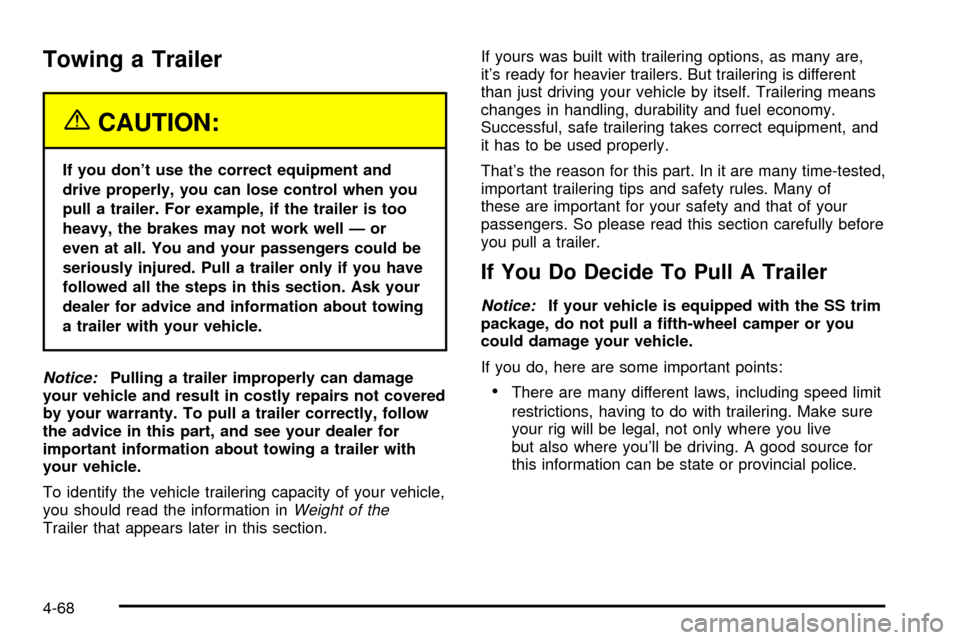
Towing a Trailer
{CAUTION:
If you don't use the correct equipment and
drive properly, you can lose control when you
pull a trailer. For example, if the trailer is too
heavy, the brakes may not work well Ð or
even at all. You and your passengers could be
seriously injured. Pull a trailer only if you have
followed all the steps in this section. Ask your
dealer for advice and information about towing
a trailer with your vehicle.
Notice:Pulling a trailer improperly can damage
your vehicle and result in costly repairs not covered
by your warranty. To pull a trailer correctly, follow
the advice in this part, and see your dealer for
important information about towing a trailer with
your vehicle.
To identify the vehicle trailering capacity of your vehicle,
you should read the information in
Weight of theTrailer that appears later in this section.If yours was built with trailering options, as many are,
it's ready for heavier trailers. But trailering is different
than just driving your vehicle by itself. Trailering means
changes in handling, durability and fuel economy.
Successful, safe trailering takes correct equipment, and
it has to be used properly.
That's the reason for this part. In it are many time-tested,
important trailering tips and safety rules. Many of
these are important for your safety and that of your
passengers. So please read this section carefully before
you pull a trailer.
If You Do Decide To Pull A Trailer
Notice:If your vehicle is equipped with the SS trim
package, do not pull a ®fth-wheel camper or you
could damage your vehicle.
If you do, here are some important points:
·There are many different laws, including speed limit
restrictions, having to do with trailering. Make sure
your rig will be legal, not only where you live
but also where you'll be driving. A good source for
this information can be state or provincial police.
4-68
Page 351 of 556

·Consider using a sway control if your trailer will
weigh less than 5,000 lbs. (2 270 kg) for light duty
vehicles, or less than 7,500 lbs. (3 405 kg) for heavy
duty vehicles. You should always use a sway control
if your trailer will weigh more than these limits. You
can ask a hitch dealer about sway controls.
·Don't tow a trailer at all during the ®rst 500 miles
(800 km) your new vehicle is driven. Your engine,
axle or other parts could be damaged.
·Then, during the ®rst 500 miles (800 km) that you tow
a trailer, don't drive over 50 mph (80 km/h) and don't
make starts at full throttle. This helps your engine
and other parts of your vehicle wear in at the heavier
loads.
·If you have an automatic transmission, you can tow
in DRIVE (D). You may want to shift the transmission
to THIRD (3) or, if necessary, a lower gear selection
if the transmission shifts too often (e.g., under heavy
loads and/or hilly conditions). If you have a manual
transmission and you are towing a trailer, it's better
not to use the highest gear. See
Tow/Haul Mode
Light on page 3-53.
Three important considerations have to do with weight:
·the weight of the trailer,
·the weight of the trailer tongue
·and the weight on your vehicle's tires.
Tow/Haul Mode
Tow/haul is a feature on automatic transmission
equipped vehicles that assists when pulling a heavy
trailer or a large or heavy load. The purpose of
the tow/haul mode is to:
·Reduce the frequency and improve the predictability
of transmission shifts when pulling a heavy trailer or
a large or heavy load.
·Provide the same solid shift feel when pulling a
heavy trailer or a large or heavy load as when
the vehicle is unloaded.
·Improve control of vehicle speed while requiring
less throttle pedal activity when pulling a heavy
trailer or a large or heavy load.
Automatic transmission equipped vehicles are provided
with a button at the end of the shift lever which when
pressed enables tow/haul. When the button is pressed,
a light on the instrument panel will illuminate to
indicate that tow/haul has been selected. Tow/haul may
be turned off by pressing the button again, at which
time the indicator light on the instrument panel will turn
off. The vehicle will automatically turn off tow/haul
every time it is started.
4-69
Page 352 of 556

Tow/haul is designed to be most effective when the
vehicle and trailer combined weight is at least 75% of
the vehicle's Gross Combined Weight Rating (GCWR).
See
Weight of the Trailerlater in the section. Tow/haul
is most useful under the following driving conditions:
·When pulling a heavy trailer or a large or heavy load
through rolling terrain.
·When pulling a heavy trailer or a large or heavy
load in stop and go traffic.
·When pulling a heavy trailer or a large or heavy
load in busy parking lots where improved low
speed control of the vehicle is desired.
Operating the vehicle in tow/haul when lightly loaded or
with no trailer at all will not cause damage. However,
there is no bene®t to the selection of tow/haul when the
vehicle is unloaded. Such a selection when unloaded
may result in unpleasant engine and transmission driving
characteristics and reduced fuel economy. Tow/haul
is recommended only when pulling a heavy trailer or a
large or heavy load.
Weight of the Trailer
How heavy can a trailer safely be?
It depends on how you plan to use your rig. For
example, speed, altitude, road grades, outside
temperature and how much your vehicle is used to pull
a trailer are all important. And, it can also depend
on any special equipment that you have on your vehicle.
Use one of the following charts to determine how
much your vehicle can weigh, based upon your vehicle
model and options.
Maximum trailer weight is calculated assuming the
driver and one passenger are in the tow vehicle and it
has all the required trailering equipment. The weight
of additional optional equipment, passengers and cargo
in the tow vehicle must be subtracted from the
maximum trailer weight.
Above the 5,000 lbs. (2 268 kg) trailer rating, the
handling/trailering suspension is required on
C-1500 models and the handling/trailering or off-road
suspension is required on K-1500 models.
4-70
Page 353 of 556
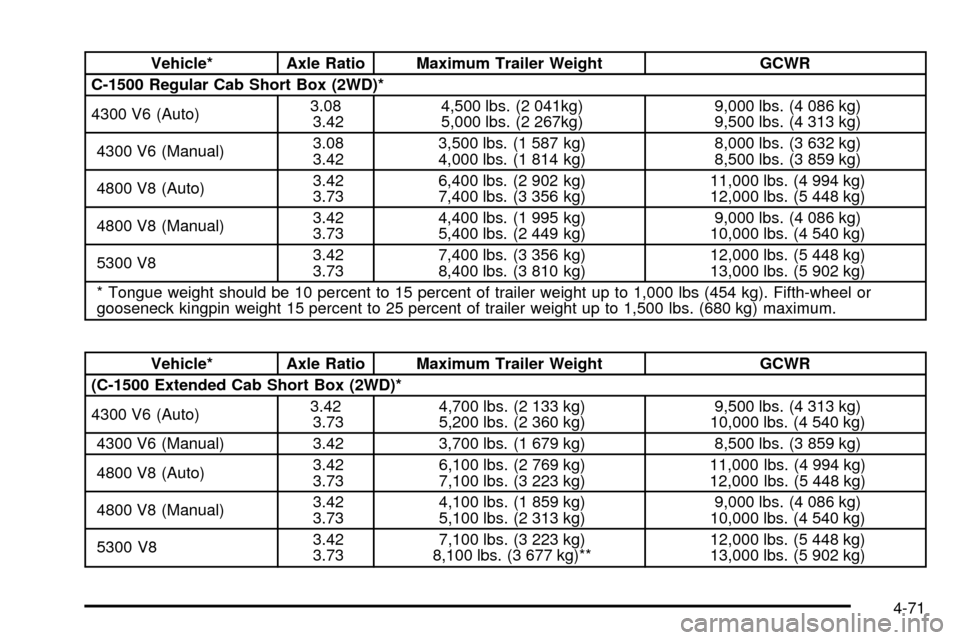
Vehicle* Axle Ratio Maximum Trailer Weight GCWR
C-1500 Regular Cab Short Box (2WD)*
4300 V6 (Auto)3.08
3.424,500 lbs. (2 041kg)
5,000 lbs. (2 267kg)9,000 lbs. (4 086 kg)
9,500 lbs. (4 313 kg)
4300 V6 (Manual)3.08
3.423,500 lbs. (1 587 kg)
4,000 lbs. (1 814 kg)8,000 lbs. (3 632 kg)
8,500 lbs. (3 859 kg)
4800 V8 (Auto)3.42
3.736,400 lbs. (2 902 kg)
7,400 lbs. (3 356 kg)11,000 lbs. (4 994 kg)
12,000 lbs. (5 448 kg)
4800 V8 (Manual)3.42
3.734,400 lbs. (1 995 kg)
5,400 lbs. (2 449 kg)9,000 lbs. (4 086 kg)
10,000 lbs. (4 540 kg)
5300 V83.42
3.737,400 lbs. (3 356 kg)
8,400 lbs. (3 810 kg)12,000 lbs. (5 448 kg)
13,000 lbs. (5 902 kg)
* Tongue weight should be 10 percent to 15 percent of trailer weight up to 1,000 lbs (454 kg). Fifth-wheel or
gooseneck kingpin weight 15 percent to 25 percent of trailer weight up to 1,500 lbs. (680 kg) maximum.
Vehicle* Axle Ratio Maximum Trailer Weight GCWR
(C-1500 Extended Cab Short Box (2WD)*
4300 V6 (Auto)3.42
3.734,700 lbs. (2 133 kg)
5,200 lbs. (2 360 kg)9,500 lbs. (4 313 kg)
10,000 lbs. (4 540 kg)
4300 V6 (Manual) 3.42 3,700 lbs. (1 679 kg) 8,500 lbs. (3 859 kg)
4800 V8 (Auto)3.42
3.736,100 lbs. (2 769 kg)
7,100 lbs. (3 223 kg)11,000 lbs. (4 994 kg)
12,000 lbs. (5 448 kg)
4800 V8 (Manual)3.42
3.734,100 lbs. (1 859 kg)
5,100 lbs. (2 313 kg)9,000 lbs. (4 086 kg)
10,000 lbs. (4 540 kg)
5300 V83.42
3.737,100 lbs. (3 223 kg)
8,100 lbs. (3 677 kg)**12,000 lbs. (5 448 kg)
13,000 lbs. (5 902 kg)
4-71
Page 354 of 556
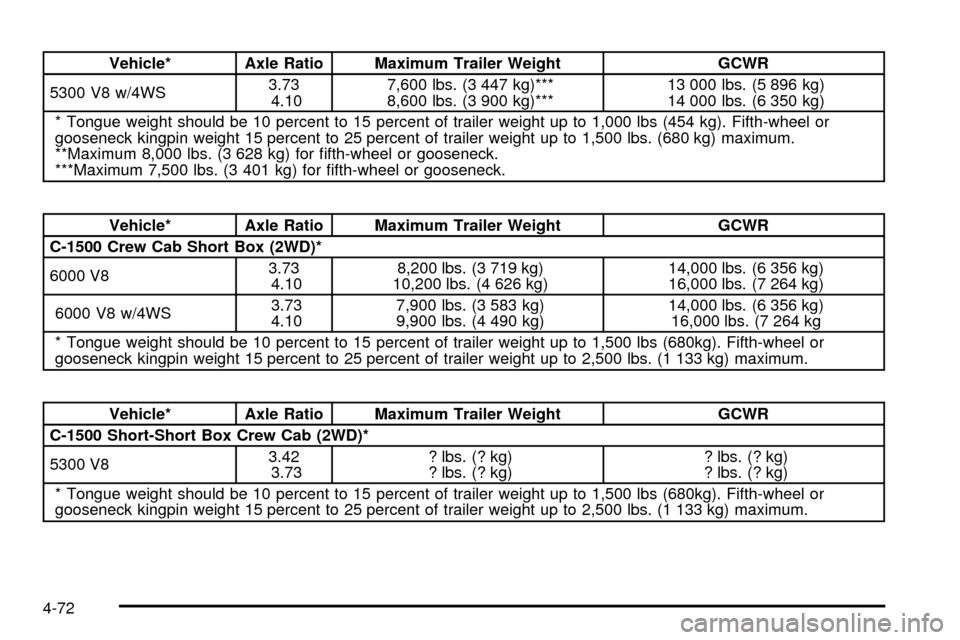
Vehicle* Axle Ratio Maximum Trailer Weight GCWR
5300 V8 w/4WS3.73
4.107,600 lbs. (3 447 kg)***
8,600 lbs. (3 900 kg)***13 000 lbs. (5 896 kg)
14 000 lbs. (6 350 kg)
* Tongue weight should be 10 percent to 15 percent of trailer weight up to 1,000 lbs (454 kg). Fifth-wheel or
gooseneck kingpin weight 15 percent to 25 percent of trailer weight up to 1,500 lbs. (680 kg) maximum.
**Maximum 8,000 lbs. (3 628 kg) for ®fth-wheel or gooseneck.
***Maximum 7,500 lbs. (3 401 kg) for ®fth-wheel or gooseneck.
Vehicle* Axle Ratio Maximum Trailer Weight GCWR
C-1500 Crew Cab Short Box (2WD)*
6000 V83.73
4.108,200 lbs. (3 719 kg)
10,200 lbs. (4 626 kg)14,000 lbs. (6 356 kg)
16,000 lbs. (7 264 kg)
6000 V8 w/4WS3.73
4.107,900 lbs. (3 583 kg)
9,900 lbs. (4 490 kg)14,000 lbs. (6 356 kg)
16,000 lbs. (7 264 kg
* Tongue weight should be 10 percent to 15 percent of trailer weight up to 1,500 lbs (680kg). Fifth-wheel or
gooseneck kingpin weight 15 percent to 25 percent of trailer weight up to 2,500 lbs. (1 133 kg) maximum.
Vehicle* Axle Ratio Maximum Trailer Weight GCWR
C-1500 Short-Short Box Crew Cab (2WD)*
5300 V83.42
3.73? lbs. (? kg)
? lbs. (? kg)? lbs. (? kg)
? lbs. (? kg)
* Tongue weight should be 10 percent to 15 percent of trailer weight up to 1,500 lbs (680kg). Fifth-wheel or
gooseneck kingpin weight 15 percent to 25 percent of trailer weight up to 2,500 lbs. (1 133 kg) maximum.
4-72
Page 355 of 556
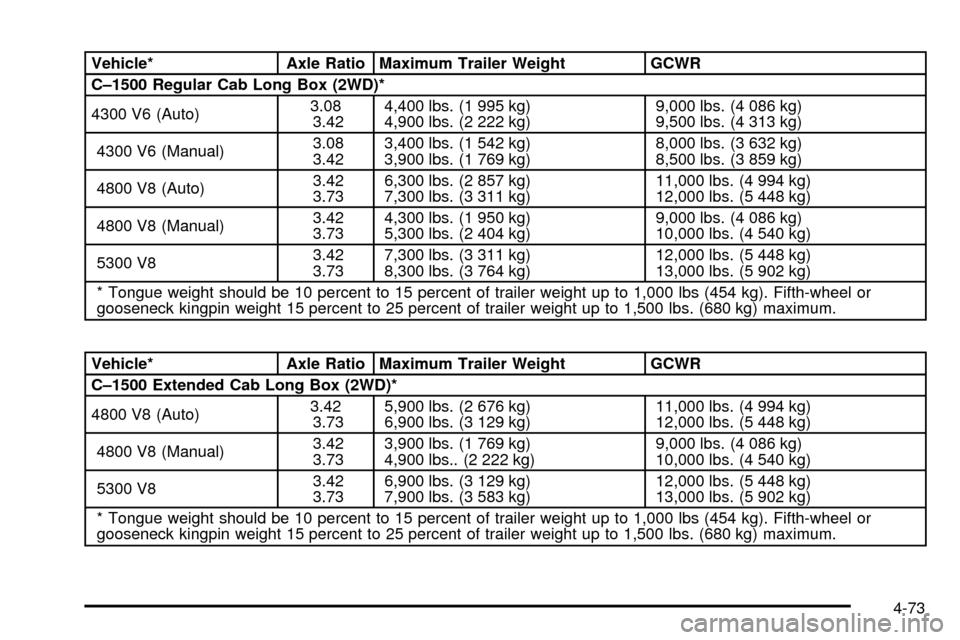
Vehicle* Axle Ratio Maximum Trailer Weight GCWR
C±1500 Regular Cab Long Box (2WD)*
4300 V6 (Auto)3.08
3.424,400 lbs. (1 995 kg)
4,900 lbs. (2 222 kg)9,000 lbs. (4 086 kg)
9,500 lbs. (4 313 kg)
4300 V6 (Manual)3.08
3.423,400 lbs. (1 542 kg)
3,900 lbs. (1 769 kg)8,000 lbs. (3 632 kg)
8,500 lbs. (3 859 kg)
4800 V8 (Auto)3.42
3.736,300 lbs. (2 857 kg)
7,300 lbs. (3 311 kg)11,000 lbs. (4 994 kg)
12,000 lbs. (5 448 kg)
4800 V8 (Manual)3.42
3.734,300 lbs. (1 950 kg)
5,300 lbs. (2 404 kg)9,000 lbs. (4 086 kg)
10,000 lbs. (4 540 kg)
5300 V83.42
3.737,300 lbs. (3 311 kg)
8,300 lbs. (3 764 kg)12,000 lbs. (5 448 kg)
13,000 lbs. (5 902 kg)
* Tongue weight should be 10 percent to 15 percent of trailer weight up to 1,000 lbs (454 kg). Fifth-wheel or
gooseneck kingpin weight 15 percent to 25 percent of trailer weight up to 1,500 lbs. (680 kg) maximum.
Vehicle* Axle Ratio Maximum Trailer Weight GCWR
C±1500 Extended Cab Long Box (2WD)*
4800 V8 (Auto)3.42
3.735,900 lbs. (2 676 kg)
6,900 lbs. (3 129 kg)11,000 lbs. (4 994 kg)
12,000 lbs. (5 448 kg)
4800 V8 (Manual)3.42
3.733,900 lbs. (1 769 kg)
4,900 lbs.. (2 222 kg)9,000 lbs. (4 086 kg)
10,000 lbs. (4 540 kg)
5300 V83.42
3.736,900 lbs. (3 129 kg)
7,900 lbs. (3 583 kg)12,000 lbs. (5 448 kg)
13,000 lbs. (5 902 kg)
* Tongue weight should be 10 percent to 15 percent of trailer weight up to 1,000 lbs (454 kg). Fifth-wheel or
gooseneck kingpin weight 15 percent to 25 percent of trailer weight up to 1,500 lbs. (680 kg) maximum.
4-73
Page 356 of 556
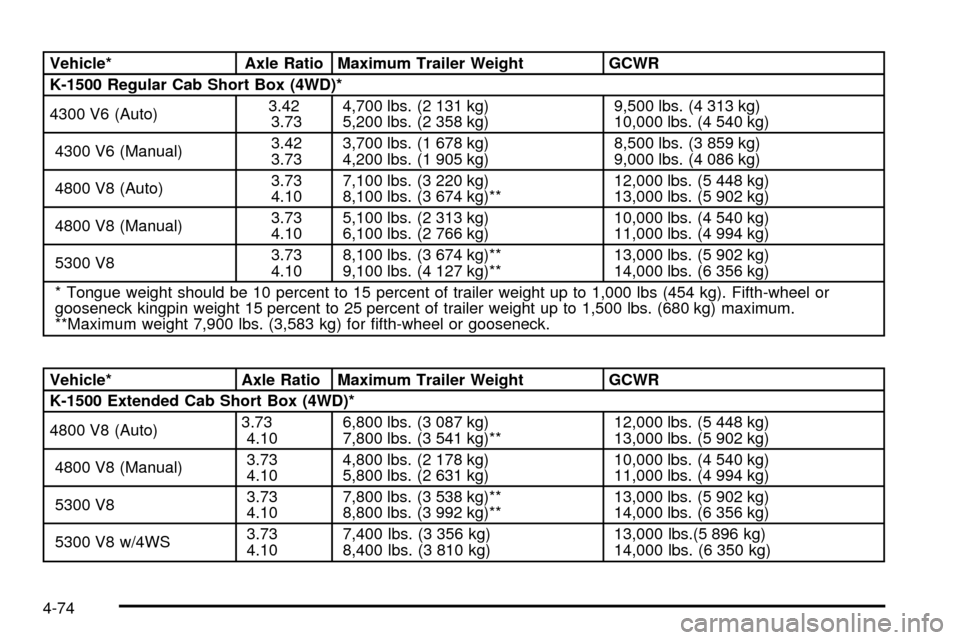
Vehicle* Axle Ratio Maximum Trailer Weight GCWR
K-1500 Regular Cab Short Box (4WD)*
4300 V6 (Auto)3.42
3.734,700 lbs. (2 131 kg)
5,200 lbs. (2 358 kg)9,500 lbs. (4 313 kg)
10,000 lbs. (4 540 kg)
4300 V6 (Manual)3.42
3.733,700 lbs. (1 678 kg)
4,200 lbs. (1 905 kg)8,500 lbs. (3 859 kg)
9,000 lbs. (4 086 kg)
4800 V8 (Auto)3.73
4.107,100 lbs. (3 220 kg)
8,100 lbs. (3 674 kg)**12,000 lbs. (5 448 kg)
13,000 lbs. (5 902 kg)
4800 V8 (Manual)3.73
4.105,100 lbs. (2 313 kg)
6,100 lbs. (2 766 kg)10,000 lbs. (4 540 kg)
11,000 lbs. (4 994 kg)
5300 V83.73
4.108,100 lbs. (3 674 kg)**
9,100 lbs. (4 127 kg)**13,000 lbs. (5 902 kg)
14,000 lbs. (6 356 kg)
* Tongue weight should be 10 percent to 15 percent of trailer weight up to 1,000 lbs (454 kg). Fifth-wheel or
gooseneck kingpin weight 15 percent to 25 percent of trailer weight up to 1,500 lbs. (680 kg) maximum.
**Maximum weight 7,900 lbs. (3,583 kg) for ®fth-wheel or gooseneck.
Vehicle* Axle Ratio Maximum Trailer Weight GCWR
K-1500 Extended Cab Short Box (4WD)*
4800 V8 (Auto)3.73
4.106,800 lbs. (3 087 kg)
7,800 lbs. (3 541 kg)**12,000 lbs. (5 448 kg)
13,000 lbs. (5 902 kg)
4800 V8 (Manual)3.73
4.104,800 lbs. (2 178 kg)
5,800 lbs. (2 631 kg)10,000 lbs. (4 540 kg)
11,000 lbs. (4 994 kg)
5300 V83.73
4.107,800 lbs. (3 538 kg)**
8,800 lbs. (3 992 kg)**13,000 lbs. (5 902 kg)
14,000 lbs. (6 356 kg)
5300 V8 w/4WS3.73
4.107,400 lbs. (3 356 kg)
8,400 lbs. (3 810 kg)13,000 lbs.(5 896 kg)
14,000 lbs. (6 350 kg)
4-74
Page 357 of 556
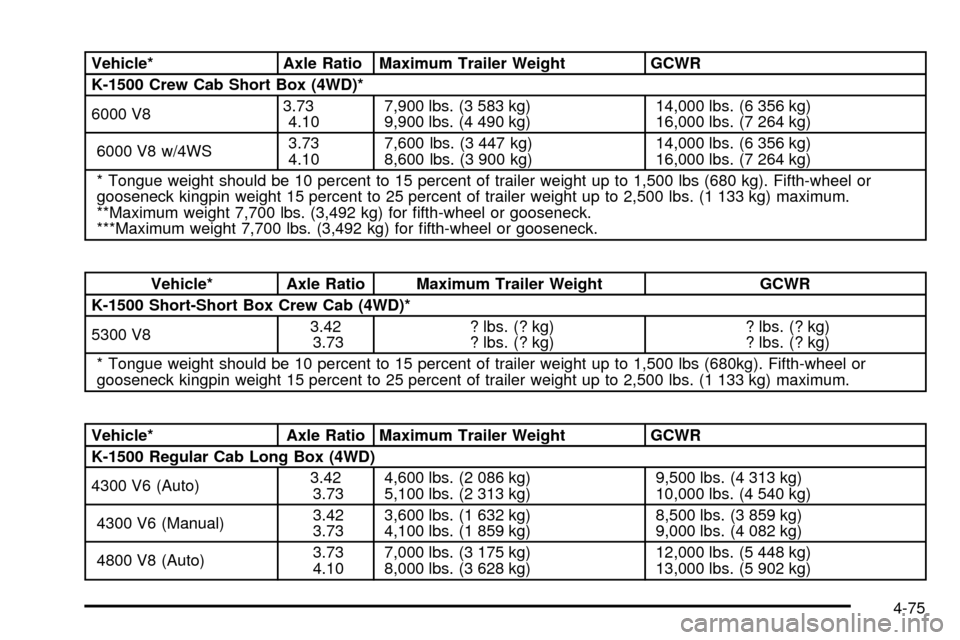
Vehicle* Axle Ratio Maximum Trailer Weight GCWR
K-1500 Crew Cab Short Box (4WD)*
6000 V83.73
4.107,900 lbs. (3 583 kg)
9,900 lbs. (4 490 kg)14,000 lbs. (6 356 kg)
16,000 lbs. (7 264 kg)
6000 V8 w/4WS3.73
4.107,600 lbs. (3 447 kg)
8,600 lbs. (3 900 kg)14,000 lbs. (6 356 kg)
16,000 lbs. (7 264 kg)
* Tongue weight should be 10 percent to 15 percent of trailer weight up to 1,500 lbs (680 kg). Fifth-wheel or
gooseneck kingpin weight 15 percent to 25 percent of trailer weight up to 2,500 lbs. (1 133 kg) maximum.
**Maximum weight 7,700 lbs. (3,492 kg) for ®fth-wheel or gooseneck.
***Maximum weight 7,700 lbs. (3,492 kg) for ®fth-wheel or gooseneck.
Vehicle* Axle Ratio Maximum Trailer Weight GCWR
K-1500 Short-Short Box Crew Cab (4WD)*
5300 V83.42
3.73? lbs. (? kg)
? lbs. (? kg)? lbs. (? kg)
? lbs. (? kg)
* Tongue weight should be 10 percent to 15 percent of trailer weight up to 1,500 lbs (680kg). Fifth-wheel or
gooseneck kingpin weight 15 percent to 25 percent of trailer weight up to 2,500 lbs. (1 133 kg) maximum.
Vehicle* Axle Ratio Maximum Trailer Weight GCWR
K-1500 Regular Cab Long Box (4WD)
4300 V6 (Auto)3.42
3.734,600 lbs. (2 086 kg)
5,100 lbs. (2 313 kg)9,500 lbs. (4 313 kg)
10,000 lbs. (4 540 kg)
4300 V6 (Manual)3.42
3.733,600 lbs. (1 632 kg)
4,100 lbs. (1 859 kg)8,500 lbs. (3 859 kg)
9,000 lbs. (4 082 kg)
4800 V8 (Auto)3.73
4.107,000 lbs. (3 175 kg)
8,000 lbs. (3 628 kg)12,000 lbs. (5 448 kg)
13,000 lbs. (5 902 kg)
4-75